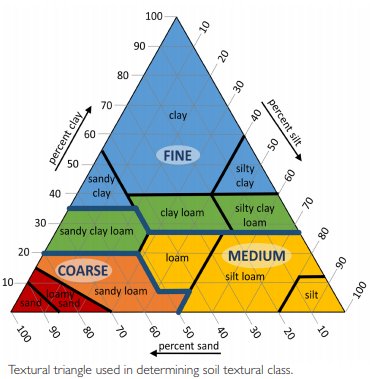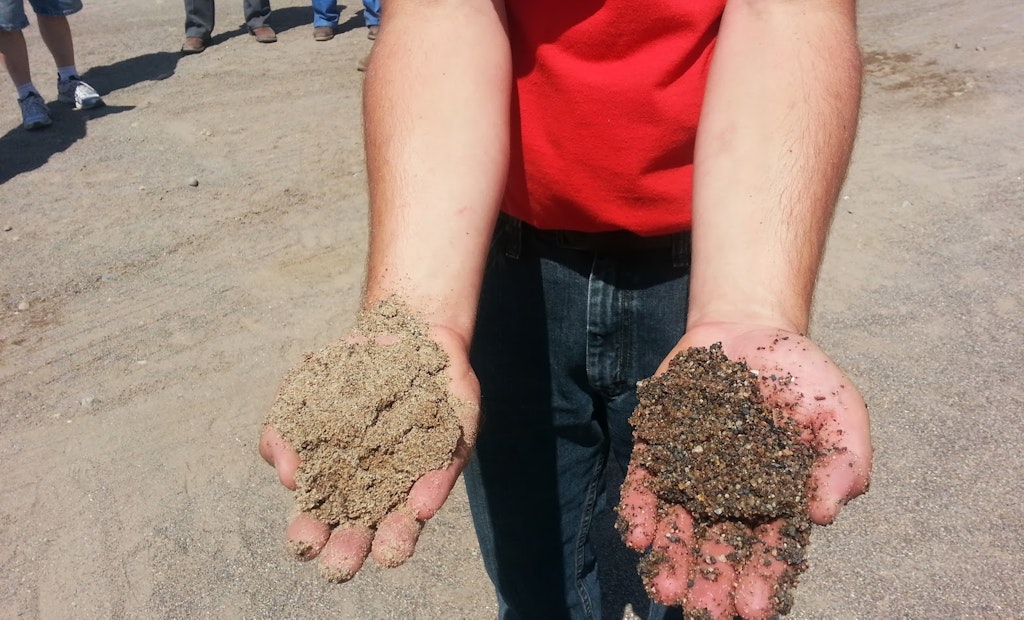Soil texture refers to the percent of sand, silt and clay in the soil. Most soil descriptions follow the United States Department of Agriculture classification for determining soil texture classes. This is also referred to as the USDA soil textural triangle.
In the USDA system, texture refers only to the particles that are less than 2 millimeters (less than 0.07 inch) in diameter. These may be referenced as the fine earth fraction in some soil reports. Organic material of all types is excluded from the textural determination. Sand-sized particles range from 0.05 to 2 millimeters in diameter; silt-sized particles range from 0.002 to 0.05 millimeter in diameter; and clay sized particles are less than 0.002 millimeter in diameter.
The amount of fragments (gravel, stones, rocks, etc.) in the soil is noted by adding the term gravelly (15-35% gravel), very gravelly (35-60% gravel), or extremely gravelly (greater than 60% gravel) to the textural class. Gravel range in size from 2 to 76 millimeters in diameter; cobbles range in size from 76 to 250 millimeters in diameter; stones range in size from 250 to 600 millimeters in diameter; boulders are greater than 600 millimeters in diameter. For example, a soil horizon described as a gravelly sandy loam has 15-35% gravel mixed into a sandy loam textured material. The fragment content could have implications for an installer in regard to excavation ease or the suitability of the native material for backfill. Soils with more than 35% fragments may not be suitable for backfilling over pipes.

While the USDA categories provide specific information about the relative amount and size of particles, it is usually sufficient to have a general knowledge of the difference between sands, loams, silts and clays. Each group has certain ramifications for system installation as well as wastewater treatment and dispersal. Sandy soils are considered coarse-textured and are often loose or non-coherent. Clays are fine-textured and often sticky when wet and coherent when wet or dry. Loams are medium-textured containing similar percentages of sand, silt and clay. They are likely to hold together when moist or dry due to the small amounts of clay within them, but they are less coherent than the clay textured soils. Silts are also medium-textured and may or may not be coherent when wet or dry dependent on the amount of clay present. Silts are highly erodible by wind or water. Silts present site challenges when it comes to sediment and erosion control.
Soil texture is used to determine loading rate ranges for designing onsite wastewater treatment systems in some codes or jurisdictions. However, texture by itself is not enough to determine loading rates; it simply helps to define the range of possibilities. As stated, texture only refers to the amount of sand, silt and clay in the soil. The installer can infer from this information something about the pore sizes in the soil. From the pore sizes, one can infer the rate at which water will flow through the soil.
Sandy soils have large pores which allow water to move rapidly as compared to clayey soils which have smaller pores. This means that sandier soils can accept more effluent than finer or clayey soils. However, if effluent moves too quickly, there may not be sufficient time for treatment processes to occur. On the other hand, finely textured soils can theoretically provide more treatment because they move water more slowly and allow retention of effluent for a longer period of time. Because more time is required to move effluent through the profile, a larger area must be set aside so that effluent does not back up.
If all other criteria are met, both types of soil will treat wastewater provided that the system is appropriately designed and properly installed. It should be designed (in part) on the basis of the soil textures present under the distribution media. Note that rock fragments (stones and boulders) may not be revealed until excavation has begun and will obviously affect installation activities.
Large pores allow water to move more quickly than small pores. Most of us know this from our days playing in a sand box or at the beach. A bucket of water poured into the sand box soaks in, whereas water ponds at the surface of clay. The reason this occurs is related to the relative pore sizes that are associated with the different textures and not due to the relative amount of pore space. In sand, the pores are larger compared to those in clay. Water is held more tightly in the small pores due to their physical properties. Think of this in terms of how a spill is wiped up. A coarse-textured cloth such as burlap does not wipe up a spill as fast as a fine-textured cloth like a cotton rag. Since the water is held tightly in small pores (clay), it cannot move as fast. Another analogy is comparing an interstate highway to back roads. More cars move faster on the interstate (large pores) than on the back roads (small pores).
Interestingly, although sand has larger pores, it also has less pore space as compared to clay. In the end it is the pore size, not the amount of pores, that controls water movement. The concept of pore space must be kept in mind during all phases of installation. Compaction due to equipment travel or excavation reduces the amount of pores and, perhaps more important, reduces the size of the pores. The end result is lower permeability and a risk of causing the effluent to not be accepted by the soil.
Porosity and drainage characteristics of materials
Material | Porosity (%) |
Clay | 45-55 |
Sand | 25-40 |
Gravel | 25-40 |
Sand and gravel | 10-35 |
Limestone | 1-10 |
In a soil with strongly contrasting textures or abrupt texture changes, water flow is restricted from one texture to another. This is obvious as most have seen where water is slowed down (perched) on top of a finer textured layer in the soil. Generally, the finest texture is considered the most limiting in the design. However, when a finer texture soil overlies a coarse-texture soil, the coarse-textured layer may also restrict flow if it is not saturated. This is related to the pore size and the relative ability of water to move into large pores when the pores are not filled with water. When the large pores are empty or nearly empty, the capillary pull (think of it as the ability of the pore to suck the water) is low compared to the finer-textured soil above. This is similar to the observation of water being in the opening of a screen or in the canvas roof of a tent. The water will not move out of those pores until there is enough pressure to force the water to enter the large void or pore. This explains why fines over gravel may show signs of saturation even when the gravel below is dry.
About the author
Sara Heger, Ph.D., is a researcher and educator in the Onsite Sewage Treatment Program in the Water Resources Center at the University of Minnesota, where she also earned her degrees in agricultural and biosystems engineering and water resource science. She presents at many local and national training events regarding the design, installation and management of septic systems and related research. Heger is the President-Elect of the National Onsite Wastewater Recycling Association and she serves on the NSF International Committee on Wastewater Treatment Systems. Ask Heger questions about septic system design, installation, maintenance and operation by sending an email to kim.peterson@colepublishing.com.






